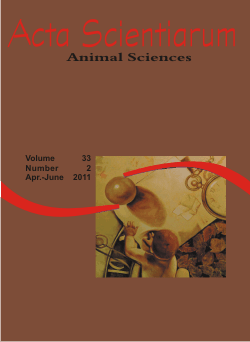<b>Genetic characterization of three Nile tilapia (GIFT strain) generations using the RAPD marker</b> - doi: 10.4025/actascianimsci.v33i2.9202
Keywords:
genetic diversity, Genetic Improvement of Farmed Tilapias, strains, genetic improvement, Oreochromis niloticus
Abstract
The aim of this work was to analyze the genetic diversity in three GIFT tilapia generations from the Genetic Improvement Program of State University of Maringá, using the RAPD marker. One hundred eighty fin samples were used. The seven primers used produced 91 fragments, of which 98.9% were polymorphic. Differences (p < 0.05) were observed in the frequency of 64 fragments, of which ten were excluded in G2. The results of genetic variability estimated by the Shannon index (G0: 0.430, G1: 0.469 and G2: 0.420) and by the percentage of polymorphic fragments (G0: 90.1%, G1: 94.5% and G2: 86.8%) indicated a high intrapopulation genetic variability, corroborated by the Nei genetic diversity results that showed G1 with the highest values (G0: 0.281, G1: 0.307 and G2: 0.277). A greater genetic distance between the G0 and G1 generations (0.108) and a greater genetic identity between G0 and G2 (0.909) were verified. Intrapopulation genetic diversity was high in the three generations, with highest values in G1.Downloads
Download data is not yet available.
Published
2011-04-28
How to Cite
Oliveira, S. N., Ribeiro, R. P., Lopera, N. M., Candioto, F. B., Resende, E. K., & Legat, A. P. (2011). <b>Genetic characterization of three Nile tilapia (GIFT strain) generations using the RAPD marker</b> - doi: 10.4025/actascianimsci.v33i2.9202. Acta Scientiarum. Animal Sciences, 33(2), 207-212. https://doi.org/10.4025/actascianimsci.v33i2.9202
Issue
Section
Animal Breeding and Reproduction
DECLARATION OF ORIGINALITY AND COPYRIGHTS
- I Declare that current article is original and has not been submitted for publication, in part or in whole, to any other national or international journal.
The copyrights belong exclusively to the authors. Published content is licensed under Creative Commons Attribution 4.0 (CC BY 4.0) guidelines, which allows sharing (copy and distribution of the material in any medium or format) and adaptation (remix, transform, and build upon the material) for any purpose, even commercially, under the terms of attribution.
Read this link for further information on how to use CC BY 4.0 properly.
0.9
2019CiteScore
29th percentile
Powered by 








































